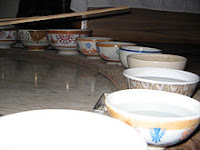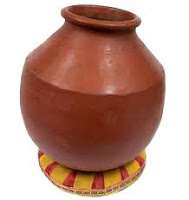Music does exist in every part of nature and can be generated from any kind of source of living and non-living organism.In our daily life we use certain stuff like our utensils which can be great source of melody in music.There are sort of music instruments that are originated from things we use in our day to day life.
 Jal Tarang :
Jal Tarang : This instrument is indian melodic percussion instrument. It is made of ceramic bowl that are arranged in semi circle order.The bowls we used for taking soup,light meal etc.are ingredients of making this instrument.The bowl are filled with water and bowls are played by striking the edge with beaters, one in each hand.by adjusting the level of water,it creates myriads of music .In indian classical music,it is categorized into Ghan Vadya.In the wave-instruments, it is the most prominent and ancient instrument. Jal-tarang was also called jal-yantra.In bollywood ,this instrument used in song '
Gharse Nikalte Hi' of movie 'Papa Kehte Hai'.
 Ghatam :
Ghatam : This instrument is nothing but Matka,Ghada or it can be Maath ,pot made up of clay.Basically Ghatam is used in South india .It is one of fine instrument in
indian carnatic music .There is analogue of it in Rajasthan called as
madga or
pani madaqa.the artist uses the fingers, thumbs, palms, and heels of the hands to strike its outer surface. An airy low-pitch bass sound, called
gumki, is created by hitting the mouth of the pot with an open hand.Like jal tarang,we can create different tones by hitting different part of Matka or Ghatam.In bollywood ,this instrument is popular & used various bollywood songs like song 'chappa Chappa Charakha chale' of movie named 'Machis' and composed by one of well known
indian musician Vishal Bharadwaj.The songs starts with tone of Ghatam.
 Ektar :
Ektar :Ektar is the medicants' drone. A round stick of about 4 feet length and less than 2" in diameter forms the finger-board. One end of this stick is provided with a tuning peg and the other end is passed through a hollow gourd resonator. It has an open string, one end of which is fastened to a nail fixed on to the projection of the stick beyond the resonator. From here, the string passes over a crude wooden bridge placed on the gourd and then fastened to the peg at the top. To increase the richness of tone, a silken or woollen thread is placed between the bridge and the string. The instrument is held either in the right hand or the left hand and the fore-finger is used to pluck the string. The gourd is nothing but the vegetable we used is our regular meal. It is called as
Bhopala or Louki in our local and national language.
Sanku or Shankha:The most ancient wind instrument known to man. It is represented in the Amaravathi and Sanchi sculptures (3rd century B.C.). It is held very sacred and reference to it is found in all the literature of India. It is one of the attributes of Sri Vishnu. The conch used by Sri Krishna was called "Panchajanya". The conch is blown through a small hole made in the spiral. It is used in temples, religious ceremonies and processions. Its tone has a distinctive quality of its own and can be heard at long distance.
 Ghungaroo:
Ghungaroo:Ghungaroo is basically used by
indian classical dancers.The sounds produced by ghungroos vary greatly in pitch depending on their metallic composition and size. Ghungroos serve to accentuate the rhythmic aspects of the dance and allow complex footwork to be heard by the audience. They are worn immediately above the ankle, resting on the lateral malleolus and medial malleolus. A string of ghungroos can range from 50 to greater than 200 bells knotted together.In bollywood ,most of the art movies songs made use of Ghungaroo.
There are many more and lot more musical instruments that are originated from stuff we use in our day to day life.Just trying to know existence of music in nature in depth.
 Jagjit Singh was born on February 8, 1941in Sri Ganganagar, Rajasthan. He had four sisters and two brothers and he is known as Jeet by his family.He has sung many songs & gazals for bollywood music & non filmi Gazals.He sungs in Hindi,Urdu,Punjabi & Nepali languages.He was the winner of Padma Bhushan for his contribution in Indian Music.He with his wife chitra who is also a Gazal singer recorded as most successful duo of husband-wife in 1970's to 1980's. He made people to listen Gazals as his voice & its expressions used to engross people. Jagjjit Singh has also sung for popular movies like Arth, Prem Geet, Sarfarosh and Tarqeeb. Jagjit Singh was the first Indian composer, and together with his wife Chitra Singh the first recording artist in the history of Indian music to use digital multi-track recording for their album, Beyond Time (1987) , that was India's first Digitally Recorded Album. On May 10, 2007, in a milestone joint session held in the historic Central Hall of India's Parliament (Sansad Bhawan), Jagjit Singh sung "Lagta nahin hai dil mera" , famous ghazal of the last Moghul Emperor, Bahadur Shah Zafar's to commemorate the 150th anniversary of India's First War of Independence that is 1857.He has given the modern face to Indian Gazals.
Jagjit Singh was born on February 8, 1941in Sri Ganganagar, Rajasthan. He had four sisters and two brothers and he is known as Jeet by his family.He has sung many songs & gazals for bollywood music & non filmi Gazals.He sungs in Hindi,Urdu,Punjabi & Nepali languages.He was the winner of Padma Bhushan for his contribution in Indian Music.He with his wife chitra who is also a Gazal singer recorded as most successful duo of husband-wife in 1970's to 1980's. He made people to listen Gazals as his voice & its expressions used to engross people. Jagjjit Singh has also sung for popular movies like Arth, Prem Geet, Sarfarosh and Tarqeeb. Jagjit Singh was the first Indian composer, and together with his wife Chitra Singh the first recording artist in the history of Indian music to use digital multi-track recording for their album, Beyond Time (1987) , that was India's first Digitally Recorded Album. On May 10, 2007, in a milestone joint session held in the historic Central Hall of India's Parliament (Sansad Bhawan), Jagjit Singh sung "Lagta nahin hai dil mera" , famous ghazal of the last Moghul Emperor, Bahadur Shah Zafar's to commemorate the 150th anniversary of India's First War of Independence that is 1857.He has given the modern face to Indian Gazals.





































